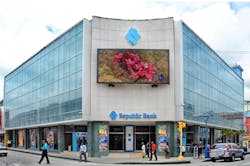Republic Bank fights high Caribbean energy costs with comprehensive lighting control
Lighting control pays off in almost any environment, but implementing aggressive control strategies is especially important in areas such as the Caribbean where $0.40 to $0.50/kWh electrical rates are as much as four times higher than US rates. Republic Bank, an institution located in Trinidad and Tobago, faced such high energy costs for eleven bank branches in Grenada, Guyana, and Barbados and turned to Lutron's Quantum Total Light Management system to reduce electricity expenses.
The Republic project is notable in that it wasn't based on a retrofit to more efficient lighting but on simple optimization in the usage of the existing lighting. The project demonstrates the value of networks and controls regardless of the light sources involved. At the same time, the bank was able to improve the workplace environment for employees and customers through uniform and comfortable light levels.
The Quantum system provides what Lutron calls "total light management" by controlling both electrical lighting and daylight to improve indoor environments and deliver energy savings. Elements of the system include products ranging from shade controls to sensors to control panels to network hubs and servers. Moreover, Quantum software both allows a building manager to set control strategies based on autonomous sensor-based input and to schedule light settings based on the time of day or day of week. Among the newest features of the system is the Quantum Vue web-based software that enables control via mobile wireless devices.
Republic Bank worked with contractor Custom AV Designs Ltd (CAVD) on the project. The bank wanted to implement strategies including daylighting, occupancy sensing, programmatic controls, and individual light level control in personal work areas. But while the Quantum system could provide the desired control features, the system presented a potential budget-busting hurdle.
Typically a Quantum system relies on a local Quantum server installed in each facility. But the servers add to the cost of an installation. CAVD, however, was able to work with the bank's IT staff to install a virtual local area network (VLAN), utilizing the bank's IT networks, in each of the three countries where the target branches were located. The virtual technology left the requisite security in place for banking operations while allowing Quantum communications to pass between branches. Therefore, the system required only three Quantum servers for 11 branches.
The result is a system with consolidated web-based control that allows managers a view into the lighting control and energy savings at each branch or collectively for the entire network. The results in terms of control strategies were immediately evident. "Thanks to the installation of the Lutron Quantum system, we can see the lights come on when needed and go off when there is no movement in a room," said Rudolph McClean, business security officer for Republic Bank, Barbados. "We can literally walk into a dark space and see the lights come on."
The energy savings are especially impressive given that a lighting retrofit was not part of the project. Documented savings range from 60% in Grenada to 91% in one Guyana branch that has the greatest access to daylight.
The bank is happy with both the lighting results and the economy, noting that customers and employees believe the lighting is more comfortable. "Our customers and the staff are very happy with the new levels of lighting, and this simple improvement has helped us reduce our lighting energy consumption up to 83%," said McClean.
For more information on daylighting and control strategies, see our recent feature article on daylight autonomy authored by Lutron.

Maury Wright | Editor in Chief
Maury Wright is an electronics engineer turned technology journalist, who has focused specifically on the LED & Lighting industry for the past decade. Wright first wrote for LEDs Magazine as a contractor in 2010, and took over as Editor-in-Chief in 2012. He has broad experience in technology areas ranging from microprocessors to digital media to wireless networks that he gained over 30 years in the trade press. Wright has experience running global editorial operations, such as during his tenure as worldwide editorial director of EDN Magazine, and has been instrumental in launching publication websites going back to the earliest days of the Internet. Wright has won numerous industry awards, including multiple ASBPE national awards for B2B journalism excellence, and has received finalist recognition for LEDs Magazine in the FOLIO Eddie Awards. He received a BS in electrical engineering from Auburn University.





